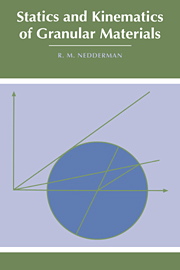Book contents
- Frontmatter
- Contents
- Notation
- 1 Introduction
- 2 The analysis of stress and strain rate
- 3 The ideal Coulomb material
- 4 Coulomb's method of wedges
- 5 The method of differential slices
- 6 Determination of physical properties
- 7 Exact stress analyses
- 8 Velocity distributions
- 9 The Conical yield function
- 10 The prediction of mass flow rate
- Set problems – chapters 2–10
- Appendices
- References and bibliography
- Index
2 - The analysis of stress and strain rate
Published online by Cambridge University Press: 28 October 2009
- Frontmatter
- Contents
- Notation
- 1 Introduction
- 2 The analysis of stress and strain rate
- 3 The ideal Coulomb material
- 4 Coulomb's method of wedges
- 5 The method of differential slices
- 6 Determination of physical properties
- 7 Exact stress analyses
- 8 Velocity distributions
- 9 The Conical yield function
- 10 The prediction of mass flow rate
- Set problems – chapters 2–10
- Appendices
- References and bibliography
- Index
Summary
Introduction
In this chapter we will develop relationships for the analysis of stress and rates of strain which will be familiar to many readers from their knowledge of fluid mechanics or elasticity. Such readers may wish to proceed directly to chapter 3, but their attention is drawn to §2.3 and §2.5 in which the sign conventions used in this book are defined, since these differ from those commonly used in fluid mechanics.
The nature of forces and stresses is discussed in §2.2 and in particular we note that force is a vector but that stress is a somewhat more complicated quantity and cannot therefore be resolved by the familiar techniques of vector resolution. The simplest method for determining the stress components on a particular plane is known as Mohr's circle and this is derived in §2.3 and compared with alternative methods in appendix 1.
Forces are generated as a result of stress gradients and these are related to the acceleration of the material by Euler's equation which is derived in §2.4. Finally in §2.5, we define the strain rate in terms of the velocity gradients and note that strain rates, like stresses, can be analysed by means of a Mohr's circle.
In an attempt to reduce the tedium of this chapter, most of the derivations are presented only for Cartesian co-ordinates and the results for other co-ordinate systems are given, without derivation, in the appendices.
- Type
- Chapter
- Information
- Statics and Kinematics of Granular Materials , pp. 7 - 20Publisher: Cambridge University PressPrint publication year: 1992



